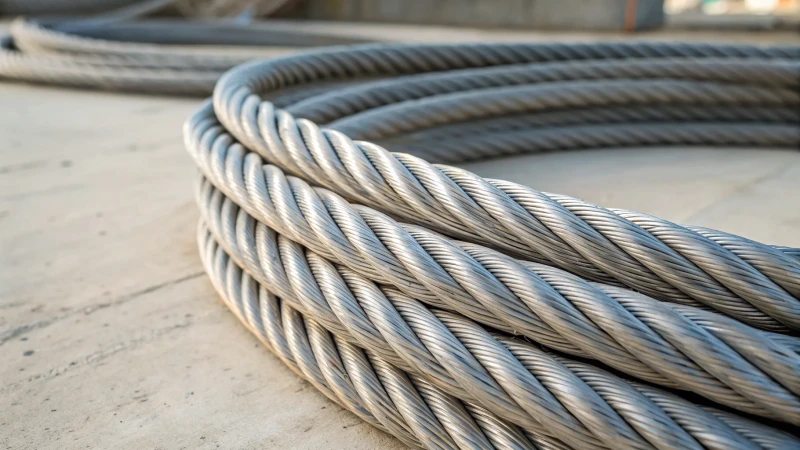
I remember standing on a construction site, staring at the massive cranes and realizing just how crucial material choice is in heavy-duty environments.
High-toughness materials, like high-carbon alloy steel and molybdenum alloy steel, significantly boost the durability of steel wire ropes. These materials enhance impact and tear resistance, extending the ropes' service life by 30% under heavy loads—ideal for demanding applications.
Thinking back to my first big project, I recall the challenge of sourcing reliable steel wire ropes that wouldn't falter under stress. That's when I learned the value of high-toughness materials. These aren't just buzzwords; they're about ensuring safety and efficiency. With a longer lifespan and better performance under tough conditions, these materials mean fewer replacements and less downtime—key factors in completing projects on schedule. Dive deeper into how these robust materials can transform your projects, offering peace of mind and reliability every step of the way.
High-toughness materials increase steel wire rope service life by 30%.True
High-toughness materials enhance durability, leading to a 30% longer lifespan.
Molybdenum alloy steel decreases the impact resistance of wire ropes.False
Molybdenum alloy steel actually increases the impact resistance of wire ropes.
How Do High-Toughness Materials Enhance Wire Rope Durability?
Ever wondered how wire ropes manage to stay strong and reliable under extreme stress?
High-toughness materials enhance wire rope durability by boosting impact resistance and minimizing wear. These robust materials, like high-carbon alloy steel, enable ropes to handle hefty loads and harsh environments, significantly prolonging their lifespan.

Understanding High-Toughness Materials
Imagine this: you're in charge of a massive construction project, and your reputation is hanging by a thread—literally! Choosing the right wire rope becomes crucial. High-toughness materials, such as high-carbon alloy steel and molybdenum alloy steel, are engineered marvels. They withstand incredible stress without breaking, thanks to their unique molecular structure that absorbs energy from impacts. This makes them perfect for high-load applications.
Impact on Wire Rope Performance
I remember a project where I had to source wire ropes for a mining operation. The ropes faced constant friction and stress. By opting for high-toughness materials, we significantly reduced wear and tear. These ropes maintained their integrity far longer than any traditional options we've used before, which meant fewer replacements and cost savings.
Application in Extreme Conditions
One time, while managing offshore drilling operations, I learned firsthand the importance of using high-toughness materials. Saltwater is a menace for conventional materials, but these alloys offered better corrosion resistance1, keeping our equipment functional longer and ensuring safety.
Technological Innovations and Techniques
It's fascinating how technology plays into this. Advanced braiding techniques combined with high-toughness materials produce ropes that can handle sudden dynamic loads—ideal for crane operations2. I've seen these innovations transform the efficiency and safety of heavy lifting projects.
Comparative Analysis
Here's a quick breakdown of how different materials stack up:
| Material Type | Durability | Impact Resistance | Corrosion Resistance |
|---|---|---|---|
| Standard Steel | Moderate | Low | Low |
| High-Carbon Alloy Steel | High | High | Moderate |
| Molybdenum Alloy Steel | Very High | Very High | High |
These insights highlight why choosing the right materials and techniques is crucial for enhancing wire rope durability. If you're curious about the specific material properties3 that contribute to toughness in industrial applications, diving deeper could be your next step.
High-toughness materials improve wire rope impact resistance.True
These materials absorb energy from impacts, enhancing durability.
Standard steel wire ropes outperform high-carbon alloy steel ropes.False
High-carbon alloy steel offers superior durability and resistance.
What Types of High-Toughness Materials Are Used in Wire Ropes?
Imagine standing at a construction site, witnessing the majestic rise of a skyscraper. Ever wonder what holds those steel beams in place? Wire ropes, crafted from high-toughness materials, are the unsung heroes.
High-toughness materials in wire ropes include high-carbon alloy steel, molybdenum alloy steel, and stainless steel. These materials enhance durability and resistance, ensuring longer service life in demanding environments.

High-Carbon Alloy Steel
When I think about high-carbon alloy steel, I remember a project where its incredible strength and durability made all the difference. This steel is my go-to for wire ropes in heavy-duty settings like construction sites or mining fields.
Properties:
- High tensile strength: It's like having a secret weapon that keeps everything in place.
- Excellent wear resistance: This means fewer replacements and more savings.
- Good fatigue life: A reliable companion in challenging conditions.
These properties make high-carbon alloy steel a preferred choice for scenarios requiring extreme durability4.
Molybdenum Alloy Steel
Molybdenum alloy steel reminds me of a sweltering day on an oil rig. Its toughness and temperature resistance are crucial when facing harsh environments.
Key Benefits:
- Enhanced toughness: It never lets me down.
- Improved thermal stability: Keeps cool under pressure.
- Resistance to corrosion: Perfect for corrosive settings like offshore rigs.
Industries like oil and gas benefit from molybdenum alloy's5 unique attributes.
Stainless Steel
Stainless steel ropes are like the cool, unflappable friend who’s always ready for an adventure. Their corrosion resistance makes them ideal for marine use.
| Grade | Characteristics |
|---|---|
| AISI 304 | Good corrosion resistance |
| AISI 316 | Superior corrosion resistance and toughness |
These grades ensure longevity in harsh conditions6. These grades are the reason my marine projects withstand the salty sea air.
Advanced Braiding Techniques
Advanced braiding techniques remind me of the intricate weaving of a spider's web—tough yet flexible. They distribute loads evenly, reducing failures. It's like having an extra layer of security when you need it most.
These techniques are critical in maximizing the performance of wire ropes7 made from high-toughness materials.
High-carbon alloy steel has excellent wear resistance.True
High-carbon alloy steel is known for its superior wear resistance, making it ideal for heavy-duty applications.
Stainless steel wire ropes are not suitable for marine use.False
Stainless steel is preferred in marine environments due to its superior corrosion resistance.
How Does Material Choice Affect Wire Rope Performance?
Ever wondered why your wire ropes perform differently across projects? The secret lies in the material!
Material choice plays a pivotal role in wire rope performance, affecting its strength, flexibility, and environmental resistance. Common materials like steel, stainless steel, and various alloys each bring unique advantages tailored to specific applications.

The Role of Material in Wire Rope Strength
When it comes to wire ropes, the material used can make all the difference. I remember a project where high-carbon steel ropes were our go-to for handling some seriously heavy-duty tasks. Their incredible tensile strength was just what we needed for construction cranes. On the other hand, when we were dealing with marine environments, stainless steel ropes were our saviors with their top-notch corrosion resistance8.
| Material | Key Benefits | Typical Applications |
|---|---|---|
| High-Carbon Steel | High tensile strength | Construction cranes, hoists |
| Stainless Steel | Corrosion resistance | Marine, chemical industries |
| Alloy Steel | Enhanced toughness | Mining, drilling operations |
Flexibility and Fatigue Resistance
I've learned that flexibility is not just a nice-to-have; it's crucial. In projects with lots of movement—think elevators and cranes—choosing a material like alloy steel9 really ups the game in terms of fatigue resistance. It’s like giving your wire ropes a second wind!
Environmental Considerations
The environment where you use your wire ropes is another factor you simply can’t ignore. In salty areas or extreme temperatures, I've often turned to materials with strong weather resistance10. Stainless steel and galvanized ropes have been my go-to in these situations.
Impact of Advanced Braiding Techniques
Finally, if you think material is the only game-changer, think again! Advanced braiding techniques can push performance even further. Once, we opted for molybdenum alloy steel combined with these modern methods, and it was like giving our ropes superpowers. They lasted longer and stood up to extreme loads like champs.
Choosing the right combination of materials and techniques doesn't just optimize performance; it ensures safety and durability in even the toughest conditions. Whether it's construction, mining, or marine applications, making informed choices about your wire ropes can save time, money, and maybe even lives.
High-carbon steel is ideal for marine environments.False
High-carbon steel lacks corrosion resistance, unsuitable for marine use.
Alloy steel enhances fatigue resistance in wire ropes.True
Alloy steel improves flexibility and fatigue resistance for frequent movement.
Why Is High-Toughness Important for Extreme Load Conditions?
Ever wondered why some materials can take a beating and keep going, especially under intense pressure?
High-toughness materials shine in extreme load conditions because they absorb impact energy, reducing the risk of catastrophic failure. Their blend of strength and ductility is key to enduring sudden, severe stress without breaking.

What Makes a Material Tough?
Think of toughness as the material's grit and resilience—its ability to absorb energy without cracking under pressure. This toughness is the superhero cape for materials, like high-carbon alloy steel11, that face high-stress situations. I remember the first time I handled this material; its robustness was palpable, and it made me appreciate the science that keeps our bridges standing strong and our machines running smoothly.
Table 1: Properties of High-Toughness Materials
| Material | Strength | Ductility | Toughness |
|---|---|---|---|
| High-Carbon Alloy | High | Moderate | Very High |
| Molybdenum Alloy | High | High | High |
Real-World Applications
Picture this: you're deep in a mining pit, surrounded by machinery that must perform perfectly despite harsh conditions. In these scenarios, high-toughness materials are the unsung heroes, ensuring the ropes remain resilient and functional. I've seen how molybdenum alloy steel12, in particular, thrives in these challenging environments, almost as if it's made for them.
The Science Behind Toughness
The secret sauce of toughness lies in the material's microstructure, tweaked and tuned through heat treatments and alloying. I recall a workshop where we explored advanced braiding techniques13 that distribute stress evenly across a material, effectively extending its lifespan. This kind of engineering wizardry ensures that materials hold up under the heaviest loads.
Table 2: Techniques to Enhance Toughness
| Technique | Impact on Microstructure |
|---|---|
| Heat Treatment | Increases grain size |
| Alloying | Enhances bond strength |
| Braiding Techniques | Distributes stress evenly |
Understanding these principles isn’t just academic—it's about designing safer systems that hold up under pressure. High-toughness materials aren't a luxury; they're a necessity for any application where reliability is non-negotiable.
High-carbon alloy steel has very high toughness.True
High-carbon alloy steel is known for its exceptional toughness.
Heat treatment decreases the grain size of materials.False
Heat treatment typically increases the grain size, enhancing toughness.
Conclusion
High-toughness materials like high-carbon and molybdenum alloy steel enhance the durability of steel wire ropes, increasing service life by 30% and improving performance in demanding environments.
-
Discover how high-toughness alloys provide superior corrosion resistance, essential for marine and harsh environment applications. ↩
-
Explore advanced braiding techniques that enhance wire rope strength and flexibility for demanding applications like crane operations. ↩
-
Learn about the specific properties that make materials tough, influencing their use in industrial applications. ↩
-
High-carbon alloy steel is known for its strength, making it ideal for demanding applications like construction. ↩
-
Molybdenum alloy steel offers enhanced toughness, crucial for environments with extreme temperatures. ↩
-
Stainless steel provides excellent corrosion resistance, essential for marine environments. ↩
-
Advanced braiding distributes loads evenly, enhancing rope longevity. ↩
-
Explore how corrosion resistance affects wire rope durability and performance, especially in marine environments. ↩
-
Learn about the advantages of using alloy steel in wire ropes for enhanced fatigue resistance. ↩
-
Discover materials that provide excellent weather resistance for wire ropes used in harsh conditions. ↩
-
Discover why high-carbon alloy steel is valued for its high toughness in critical applications. ↩
-
Explore how molybdenum alloy steel withstands harsh mining conditions. ↩
-
Learn about the latest braiding techniques that enhance wire rope toughness. ↩

